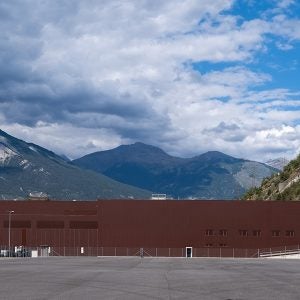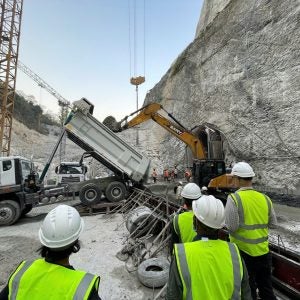
At least 58 people have been killed and many more still missing following the collapse of Dam 1 of the Córrego do Feijão mine in Brumadinho, Minas Gerais state, with operator Vale still trying to ascertain the cause of the collapse.
The dam breached on Friday afternoon and part of its contents hit two small sediment containment basins, B4 and B4A, which were downstream of the dam. According to Vale the dam was inactive and the decommissioning of the dam was in development. At the time of the breach, employees were working in the administrative area when it was hit by the tailings. Rescue and care of those affected is being carried out on site by the Fire Department and Civil Defense.
The dam was built in 1976 by Ferteco Mineração (acquired by Vale on April 27, 2001), using the upstream method. The height of the dam was 86m and had a crest length of 720m. The waste disposal area was 249.5 thousand m2 and the volume disposed was 11.7 million m3.
Vale said that the dam had ‘Stability Condition Statements’ issued by TUV SUD do Brasil, an international company specializing in Geotechnics. The ‘Stability Condition Statements’ were issued on 13/06/18 and 26/09/18, related to the Periodic Safety Review of Dams and Regular Dam Safety Inspection processes, respectively, as determined by DNPM Decree 70.389 / 2017. The dam had a Safety Factor in accordance with world best practices and was above the Brazilian Standard reference point.
The Dam went through biweekly field inspections, all of which were reported to ANM (National Mining Agency) through the SIGBM (Integrated System for Safety Management of Mining Dams). The last inspection registered on the ANM system was executed on 21/12/18. In addition, it underwent inspections on 1/8/19 and 22/01/19, and was registered on Vale's own monitoring system. The registration of each inspection on the ANM, according to legislation, must be executed by the end of the following fortnightly period. All these inspections did not detect any change in the state of the structure.
The dam had 94 piezometers and 41 Water Level Indicators to monitor its integrity. The information from the instruments was collected periodically and all their data analyzed by the geotechnitians responsible for the dam. Of the 94 piezometers, 46 were automated.
The dam also had an PAEBM (Mining Dam Emergency Action Plan), as established by DNPM regulation 70.389 / 2017. The same was filed in Federal, State and Municipal Civil Defenses between June and September of 2018. The PAEBM was constructed based on a hypothetical breach study that defined the flooding area. In addition, the dam had a video monitoring system, siren alert system (all tested) and downstream population registration. The external emergency simulation was also carried out on 16/06/2018, under the coordination of Civil Defenses, with Vale's full support, and internal training with employees on 23/10/18.
In spite of all the points described above, Vale said it is still investigating to find the cause of the collapse and will provide more information as soon as it becomes available. Vale's CEO, Fabio Schvartsman said in Brumadinho over the weekend that Vale has created a working group that in the next few days will present a plan to raise the safety standard of the company's dams. The objective, according to him, is to overcome the most rigorous parameters that exist today in Brazil and in the world.
"It seems to me that there is only one solution: we have to go beyond any standard, national or international. We are going to create a safety mattress that is far superior to what we have today," Schvartsman said.
There were further worries at the weekend that another tailings dam owned by Vale was unstable. At about 5:30 am on Sunday, warning sirens were triggered after monitoring instruments of Dam 6 detected an increase in water levels. As a precautionary measure, the community in the region was being evacuated, but later in the day the Civil Defense lowered the critical level of the dam, and people were allowed back to their homes.
The search for those missing is still continuing.
Image: Vale's CEO, Fabio Schvartsman, on a flyby over the site






